Fiction and monthly magazines in Britain
Fiction has been a mainstay of monthly magazines for centuries. Periodicals from the big book publishers in the Victorian era focused on serialising their titles, but The Strand adopted a different strategy from 1891 with the Sherlock Holmes standalone monthly stories. It was an approach that paid dividends, though like most monthlies, The Strand carried non-fiction and other types of articles. It also led the way in being highly illustrated.
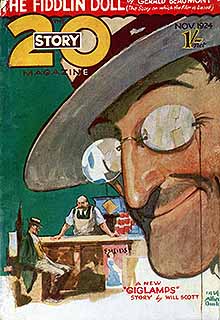 20 Story magazine from November 1924 with a 'Giglamps' cover story by Will Scott |
20 StoryGeorge Newnes, general monthlyMagazine 'for boys and old boys' |
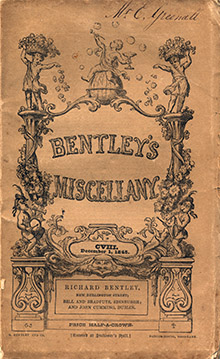 Bentley's Miscellany from December 1845. This cover has some copperplate writing: Mr E Greenall |
Bentley's MiscellanyRichard Bentley, New Burlington St. Printed by S&J Bentley, Wilson & Fley, Bangor House, Shoe Lane. 1836-68Bentley's Miscellany was a small format monthly published by Richard Bentley. It was later merged into Temple Bar. The cover states that it was 'entered at Stationers’ Hall', which was the main method of protecting copyright at the time. A typical issue was 104 book-like pages plus advertising and an engraving for the frontispiece. It cost 2/6. The cover design was by 'G.C.'. Charles Dickens was the editor of Bentley's Miscellany for two years. He wrote poems and sketches as well as stories. Oliver Twist was first published in Bentley's in 24 parts, from February 1837 to April 1839.The advert on the inside front cover for the December 1845 issue was for J Schweppe's and his tonic water. A later page carries text starting 'The undernamed Contributions are declined, with many thanks, and lie at the Publisher’s'. It goes on to list several names. Two of the main fiction pieces include 'The Marchioness of Brinvilliers, the Poisoner of the Seventeenth Century: A Romance of Old Paris' by Albert Smith. It was illustrated by J. Leech, possibly the Punch illustrator. Accompanying this is a Memoir of Albert Smith with a plate showing the writer. There are later versions of this plate, one dated 1858. Another feature was 'Glimpses and Mysteries' by Alfred Crowquill, a pen name of Alfred Henry Forrester. |
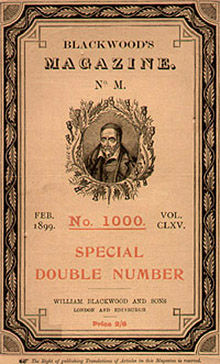 Blackwood's magazine cover 1899 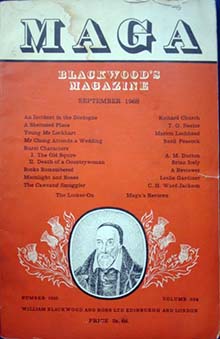 Maga magazine cover 1968 |
Blackwood'sWilliam Blackwood (founder). April 1817-1980Founded as Blackwood’s Edinburgh Magazine. The first editors were Thomas Pringle and James Cleghorn. In 1905, it moved its headquarters to London and shortened its name to Blackwood's Magazine. It was known as Maga, and used that as its title in the 1960s. Published many books that would become classics as serials in the Victorian era, including Conrad’s Heart of Darkness, later filmed as Apocalypse Now. |
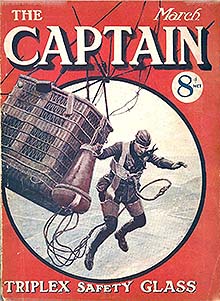 Captain cover from 1918 showing a parachute jump |
CaptainGeorge Newnes, general monthlyMagazine 'for boys and old boys' |
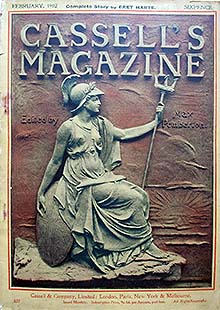 Cassell's magazine in February 1902 |
Cassell'sCassell, fiction monthlyBook publisher's magazine |
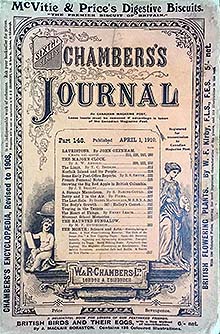 chambers-journal-1910-april.jpg 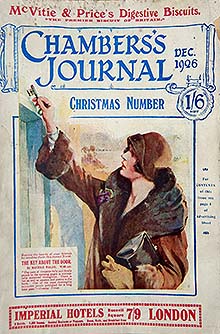 December 1926 Chambers's Journal |
Chambers's JournalChambers, general monthlyNote the awkward title – Chambers's. Chambers was a mainstraem publisher, and is still known for its dictionary. |
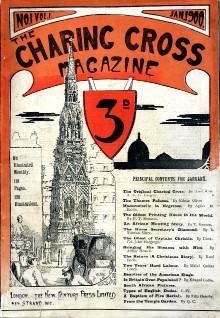 First issue of Charing Cross magazine in 1900 |
Charing CrossNew Century Press, 434 Strand, London. Illustrated Monthly. 3dThe first issue carried articles on the Original Charing Cross, the Thames palaces, the oldest printing house in the world, beauties of the American stage, pictures of South Africa, and fiction. The London junction takes its name from the medieval Eleanor cross that stood on the site from the 13th century until 1647. Road distances from London are still measured from Charing Cross. |
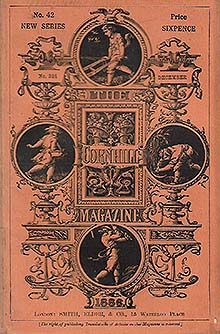 Cornhill magazine in 1886 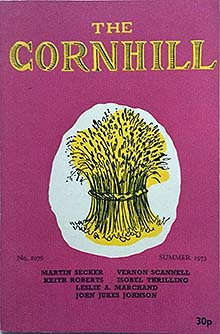 The image of the reaper from the first issue was a constant on Cornhill magazine covers |
CornhillSmith, Elder, & co/John Murray, London Illustrated MonthlyEarly issues were illustrated by the Pre-Raphaelites. |
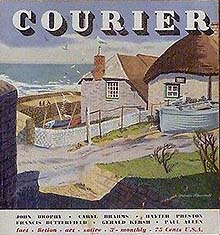 Courier magazine, March 1954 |
CourierNorman Kark Publications, London. Illustrated monthlySquare format. |
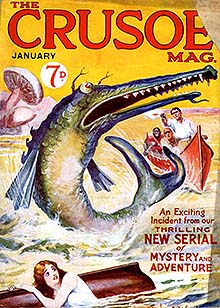 Crusoe magazine, January 1925 |
CrusoeGeorge Newnes, London. Fiction monthlyDynamic colour covers were wrapped around book-style pages. |
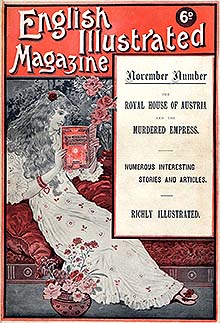 English Illustrated November 1898 |
English IllustratedCassell, general monthly |
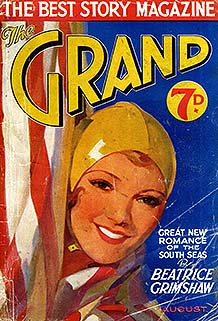 Grand story magazine in August 1932 |
GrandGeorge Newnes, fiction monthly |
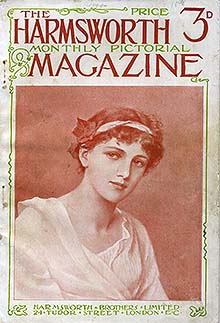 Harmsworth magazine from July 1898 |
HarmsworthHarmsworth Brothers, general monthlyHarmsworth was later relaunched as The London |
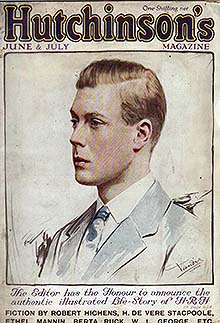 Hutchinson's magazine from June 1926 |
Hutchinson'sHutchinson & Co, 34 Paternoster Row, LondonProduced by Hutchinson & Co book publishers |
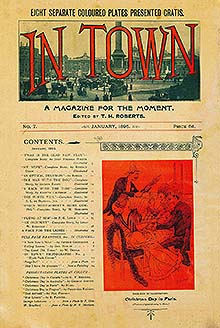 In Town January 1895 |
In TownGeneral monthlyLarge format |
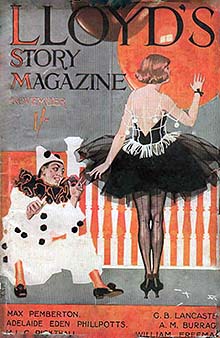 Lloyd's Story Magazine November 1921 |
Lloyd's Story MagazineFiction monthly |
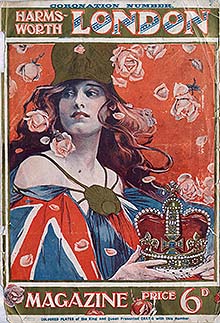 London magazine in June 1902 |
The LondonHarmsworth Brothers, general monthlyRelaunched Harmsworth magazine |
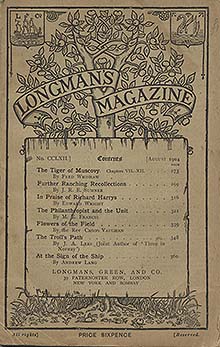 Longman's magazine in August 1904 |
Longman'sFiction monthlyFrom book publisher |
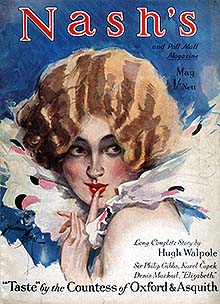 Nash's Pall Mall in May 1926 |
Nash's Pall MallGeneral monthlyNash's absorbed Pall Mall in 1916 and carried on using the latter name on its cover till it closed. |
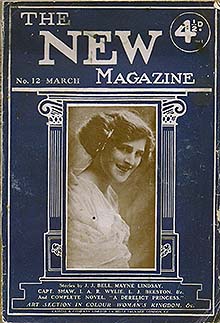 New Magazine in March 1910 |
New MagazineCassell, general monthlyRelaunched Harmsworth magazine |
 Pall Mall magazine cover September 1904 |
Pall MallGeneral illustrated monthly. May 1893 to August 1914William Waldorf Astor inherited a vast fortune in 1890 and left the US to settle in Britain, where he bought Cliveden manor in Buckinghamshire. He later built an office and home at 2 Temple Place on London's Embankment and set up a publishing empire by buying the Pall Mall Gazette and The Observer (in 1911) newspapers. He changed the polictical allegiance of the Gazette from radical to conservative and the editor, WT Stead, left. In response, George Newnes refounded the Westminster Gazette to back the Liberal Party in January 1893. Also, Newnes and Stead joined forces to establish the weekly Review of Reviews; although the partnership lasted just months, Stead made a success of the Review alone and launched international editions. That same year, Astor launched Pall Mall magazine as an illustrated monthly with a similar format to the Strand. |
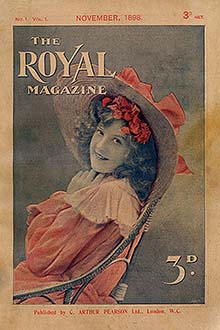 Royal magazine November 1898, the first issue. The coloured photograph was by Lallie Charles |
The RoyalArthur Pearson. General illustrated monthly. November 1898 to September 1939 (as Screen Pictorial)The first issue claimed that a million copies were printed. The Royal closed when war broke out, though it had changed its name several times, finally to Screen Pictorial. In 1935, the gravure souvenir album of The Royal Screen Pictorial was promoted with advertising in George Newnes magazines such as Woman's Own. |
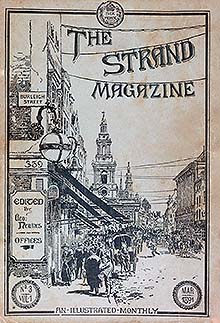 Strand magazine from March 1891 when it was founded in Burleigh Street 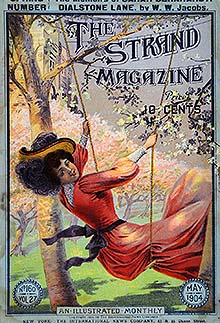 US editions of the Strand used colour covers by 1904 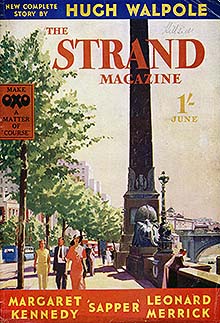 Later Strand covers moved away from the famous street; this cover shows Cleopatra's Needle on The Embankment, about half a mile away (June 1935) |
The StrandGeorge Newnes, illustrated general monthlyThe Strand started with a cover date of January 1891 and became a goldmine for its publisher, George Newnes, selling about 300,000 copies a month for the next 40 years in Britain and another 100,000 in the US until 1916. From the start, it was published in America with much the same content, but a month later, with its own editor, James Walter Smith. It was a trendsetting title, with an illustration on every page, a dedicated puzzles page and publishing not only Conan Doyle but also E.W. Hornung, H.G. Wells, E. Nesbit, Rudyard Kipling, O. Henry, and P. G. Wodehouse. The cover stated 'edited by Geo. Newnes' until 1914, but the power behind the editorial throne was Herbert Greenhough Smith, the literary editor, who worked on the magazine from 1891 to 1930. The magazine's offices were in Burleigh Street off The Strand in London. It was originally to be called the Burleigh Street Magazine, but this was too long, so the Strand Magazine was chosen. Its first cover design by George Charles Haité – like that of Richard Doyle's for Punch – was long-lasting and is an icon of illustrationMore about The Strand magazine and George Haité's iconic cover |
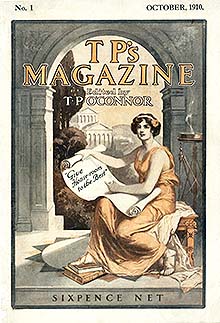 First issue of TP's Magazine, October 1910 |
TP's MagazineTP O'Connor/Cassell. General monthlyThomas Power ‘TP’ O’Connor was a leading journalist and MP in the late Victorian and Edwardian eras. ‘Tay Pay’ wrote for the Pall Mall Gazette and was a pioneer is establishing the ‘New Journalism’. He had already achieved a ‘dominant circulation’ with The Star, a radical political daily he founded in 1888, and established the Weekly Sun (1891). These pithily-written newspapers helped pave the way for Harmsworth's Daily Mail (1896) and Pearon's Daily Express (1900). In November 1902, he launched TP's Weekly. O’Connor has a memorial in Fleet Street, as well as Charles Dickens, Northcliffe (Alfred Harmsworth) and Edgar Wallace. |
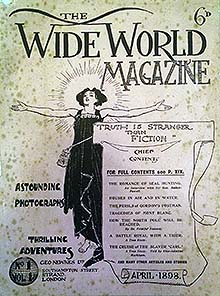 Wide World Magazine first issue in April 1898 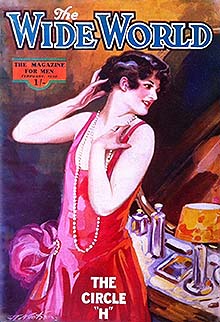 Wide World Magazine, February 1930: 'a magazine for men' |
Wide WorldGeorge Newnes, travel and adventure monthly. 1898-1962'Truth is stranger than fiction' was the motto on the cover of the first issue, which promised 'astounding photographs' and 'thrilling adventures'. In the 1920s it marketed itself as a magazine for men. |
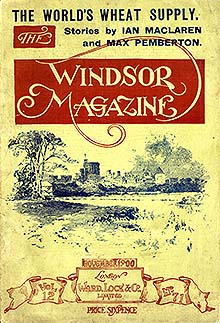 Windsor magazine, November 1900 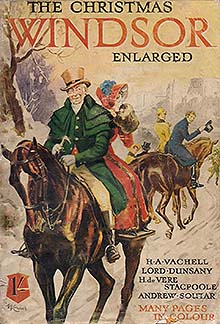 Windsor magazine, December 1937 |
Windsor MagazineWard Lock & Co, January 1895 to September 1939. General monthly |


